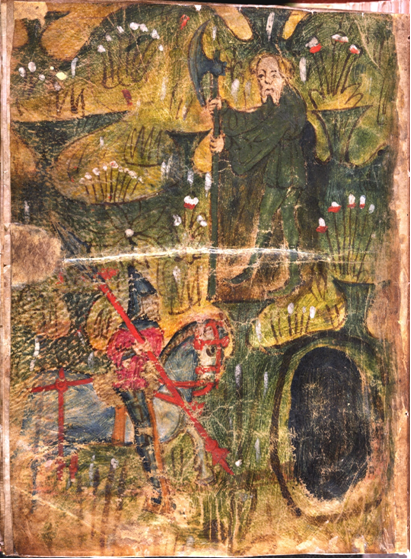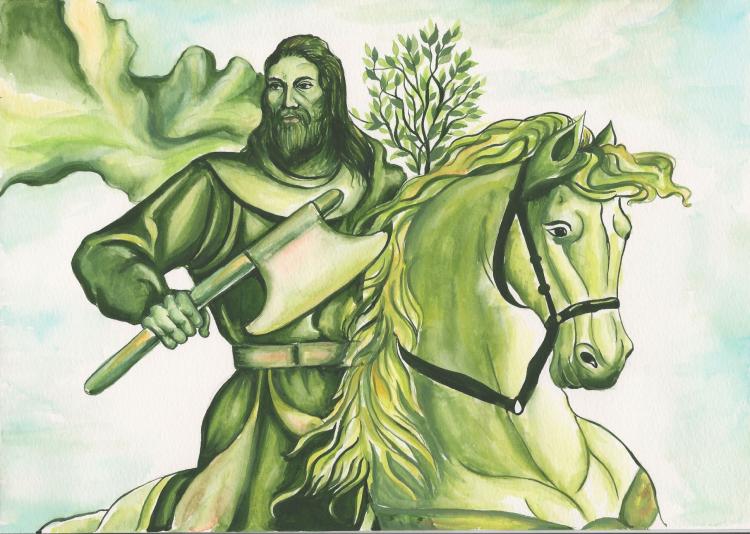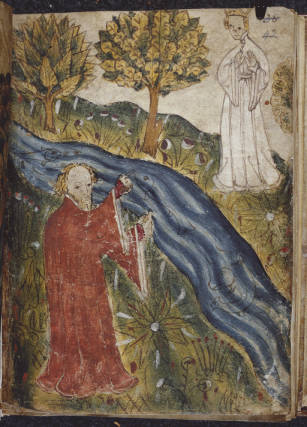[This post, part of an effort to merge our undergraduate and graduate blogs, was written in response to an essay prompt for Kathryn Kerby-Fulton's undergraduate course on "Chaucer's Biggest Rivals: The Alliterative Poets." It comes from the former "Medieval Undergraduate Research" website.]
The following is taken from Sir Gawain and the Green Knight, as Gawain and the Green Knight honor their agreement set a year prior.
Original Text, lines 2309-2329
He lyftes lyȝtly his lome, and let hit doun fayre [2309]
( vs: He gathered the grim axe and guided it well)
With þe barbe of þe bitte bi þe bare nek;
Þaȝ he homered heterly, hurt hym no more
Bot snyrt hym on þat on syde, þat seuered þe hyde.
Þe scharp schrank to þe flesche þurȝ þe schyre grece, [2313]
Þat þe schene blod ouer his schulderes schot to þe erþe;
And quen þe burne seȝ þe blode blenk on þe snawe,
He sprit forth spenne-fote more þen a spere lenþe,
Hent heterly his helme, and on his hed cast, [2317]
Schot with his schulderez his fayre schelde vnder,
Braydez out a bryȝt sworde, and bremely he spekez–
Neuer syn þat he watz burne borne of his moder
Watz he neuer in þis worlde wyȝe half so blyþe– [2321]
‘Blynne, burne, of þy bur, bede me no mo!
I haf a stroke in þis sted withoute stryf hent,
And if þow rechez me any mo, I redyly schal quyte,
And ȝelde ȝederly aȝayn–and þerto ȝe tryst– [2325]
and foo.
Bot on stroke here me fallez–
Þe couenaunt schop ryȝt so,
Fermed in Arþurez hallez–
And þerfore, hende, now hoo!’ [2329]
My Modern Translation
He lifts lightly his axe, and let it down fair
With the barbe of the blade by the bare neck.
Though he hammered heartily, hurt him no more
But save a cut to the side that severed the hide.
The sharp sank into the flesh parting the white flesh,
That the sheen of blood over his shoulders shot to the earth.
And when he saw the blood blank on the snow,
He jumped forth with feet together more than the length of a spear,
Grabbing heartily his helmet and putting it on,
Covering with his shoulders his fair shield behind,
Brandished a bright sword and fiercely he spoke—
Never since he was born of his mother
Was he never in this world half so happy–
‘Happily put away your sword, bid me no more!
I have a stroke in this stead without receiving strife
And if you reach me any more, I readily shall repay
And I say quickly again—and thereto the trust—
and wickedly.
But one strike here falls on me–
The covenant stops correctly so
That was formed in Arthur’s halls–
And therefore, noble, now stop!

This passage signifies a release from the bounds of duty and agreement. With it comes a physical element—the cutting of Gawain’s neck to bear testament to his encounter and compliance. This sign also marks a transition in the passage, as Gawain understands the significance of the bloody visual. In Marie Borroff’s translation, however, Gawain’s injury is described in more muted language, and as a result, transfers less weight to Sir Gawain’s courageous rebuke.
In its original form, the passage is immediately characterized by the alliteration seen throughout the entirety of the work. While alliteration serves many purposes, its use within this passage is primarily to direct momentum and illustrate power. In the first line, the text reads, “He lyftes lyȝtly his lome, and let hit doun fayre” (2309). Immediately a sense of fluidity and elegance surrounds the Green Knight as he lifts his axe. This is due solely to the softness of the “l” sounds that fill the line, as repetition of these words creates a rolling sensation, providing an audible momentum to match the motion of the axe. The next line serves as stark contrast, since words such as “barbe”, and “bitte” (2310) have closed sounds that oppose the open fluidity of the line before it. As such, the first two lines together bear opposite tonal qualities and hint at broader significance. The parity of openness and closure fit both with the theme of execution—as one’s life is ended, and with the termination of Gawain’s covenant—as his contract is closed. These two possibilities are inherently at odds with each other. This is fitting, as in many ways, Sir Gawain and the Green Knight is a tale of opposites; chivalry and courtesy, loyalty and preservation, and desire and chastity are but a few pairs of conflicting forces that come to define the work. Within the sonic contrast in the first two lines, the poet embeds the struggle between Gawain and The Green Knight within the thematic structure of direct opposition.
The Green Knight is dominant in the beginning of this passage. However, the distribution of power quickly shifts when Gawain sees his own blood splatter on the snow. To mark this transition, the poet begins the line with “and,” a word that has little sonic magnitude, making the word to a neutral marker. Both lines before this begin with “Þe” and “Þat” (2313,2314), while the two lines following begin with “He” and “Hent” (2315, 2316), respectively, and thus serves to further isolate this transitional line. Upon seeing the blood, Gawain realizes his pact is fulfilled and is thus placed on even ground with the Green Knight. The poet gives him an increasing amount of power as he speaks out against the knight. “Braydez out a bryȝt sworde, and bremely he spekez” (2319), writes the poet, mimicking the “b sound” that defined the action of the axe only moments before. This is further compounded in Gawain’s language, as he commands, “Blynne, burne, of þy bur, bede me no mo!” (2322). In total transition, and demonstrated through alliteration, the power held by the Green Knight now lies in the armored hands of Gawain.
This transition of power and tonal clash, while still present in the Borroff translation, is not as stylistically developed. In place of soft “l” sounds, Marie Borroff opts for a line filled with “g” words that are more reconcilable with the “b” sounds that follow. Furthermore, Gawain’s moment of realization is softened in Borroff’s translation. The vivid—and grotesque—desription of bloodshed is greatly diminished in the translation, and as a result the moment of freedom, and thus the lynchpin on which power swings is transitively cast into shadow. What should be translated as a “stream” of blood “[shooting] to earth,” is written as a “little blood lightly leapt to earth” (2314). Such a softening of language mutes the gravity of the situation, thus undermining the theme of Gawain’s inescapable mortality that runs throughout the work. As such, Gawain’s transition into a bold figure is dramatically lessened in Marie Borroff’s translation and does not allow him to fully embrace the knightly values of courage and bravery.
Michael Duffey
University of Notre Dame


